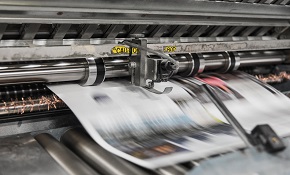24 6 月, 2022
European paper firms bank on investment | Analysis
Moody’s says Euro paper market capital expenditure is to rise and many will want to strengthen their packaging sector presence, writes Waqas Qureshi.

Corrugated is the sector where the pace of change has been breathtaking. The recent developments surrounding Smurfit Kappa (see page 3) point to a landscape that’s shifting – and fast. And it’s not just in merger and acquisition activity. The major players in the corrugated and paper market are looking to invest and upgrade their manufacturing sites.
This is recognised in a new report by Moody’s Investors Service, which found that a number of companies in this sector are forecast to increase revenue and maintain or increase their capital expenditure (CAPEX) in 2015.
Outlook stable
The report names the big players in the paper market including Metsa Board, Mondi, Sappi, Smurfit Kappa, Stora Enso and UPMKymmene.
“We expect the aggregate operating income of Moody’s rated European paper and forest product companies to increase by 1% to 3% over the next 12-18 months,” says Matthias Volkmer, a Moody’s vice president – senior analyst and author of the report.
The ratings agency adds that a focus on paper operations was risky in the current environment.
“This reflects our expectation that increased operating earnings from packaging operations will outweigh those from paper operations, which continue to face secular declines, which is why our outlook for the sector is stable,” explains Volkmer.
Moody’s found that more diversified firms in the sector posted solid growth last year, reflecting their efforts to reposition or broaden their business profiles away from the mature European paper market through sizeable, and ongoing, investments in related segments and through cost cutting.
The report warns that due to a 3% decline in graphic paper demand in 2014, European paper and forest product companies with narrow product offerings would need to make significant efforts to improve their business prospects. In other words, get into new markets or get left behind. The current market conditions suggest that packaging is a stronger bet.
Nicholas Mockett, head of packaging M&A, Moorgate Capital, says companies in growth markets, such as packaging grades, are likely to continue to invest in efficiencies and capacity expansion.
“The challenge is trying to keep supply and demand in equilibrium as the CAPEX in paper making is lumpy, rather than gradual, given the scale of the machines.
Mockett adds: “Players in the paper industry, where demand is dropping, will spend on efficiencies and maintenance but may struggle to justify expansion CAPEX. However, there have been cases of graphic grade mills being converted to packaging grades, which may cause dis-equilibrium and hurt the earnings of the packaging paper industry overall.”
Graham Carberry, director at Livingstone Partners, says that the industry knows that opportunities in paper manufacturing are very limited so corporate activity is driven by reducing operating costs relative to production.
“The value is created through the conversion, whether it is film lined cartonboard to create barrier properties or metallic finishing for better visual appeal and the creation of the pack,” he says.
Adaptable
Carberry adds: “Packaging can vary format and medium and adapt to new trends and opportunities – whether customer choice or legislative driven, this simply isn’t the case for the paper manufacturers. The growth of Asian manufacturers threatens European paper in a way that the packaging sector, with its need to be close to food production and the high level of customer interaction and food safety legislation requirements, is not.”
He also says that despite being linked in many people’s minds, the dynamics and prospects of paper and of packaging are very different.
Moody’s explains that players with a narrow product focus face substantial challenges as they seek to improve their business prospects in 2015 and beyond.
While most corporate strategies remain unchanged, a high number of new senior management appointments could indicate that a refocus is about to take place.
“Expansion plans continue to drive CAPEX in 2015,” said Volkmer. “We expect Metsa Board, Mondi, Sappi, Smurfit Kappa, Stora Enso and UPM to maintain or even increase spending on their, in some cases, already sizable CAPEX programmes this year.”
To this end, Smurfit Kappa has snapped up UK corrugated specialist Inspirepac, which was commended by Moody’s. The international ratings agency says that although the transaction will not affect the corrugated giant in terms of its size and financial metrics, the deal will complement Smurfit Kappa’s dominant position in the UK market and expands its existing capabilities in the high-quality-print and point-of-sale markets.
Volkmer explains: “Smurfit Kappa Group’s credit quality improves when it builds long-term value through acquisitions funded from operating cash flow, rather than pursue more shareholder friendly financial policies.
“Both its geographic diversity and its integrated model have contributed to more robust earnings.”
He says that the euro’s depreciation is driving up input costs for non- or partly integrated pulp producers.
“The substantial new pulp capacity ramping up in Latin America during 2014, mostly in hardwood pulp, was favourable for non- or partly integrated players, such as Norske Skog and Lecta because it temporarily pushed down prices. However, as the companies’ sales are mainly in euros, while their main input material, pulp, is traded in US dollars, we expect them to face increased cost pressure in 2015 as a result of the euro’s weakness against the US dollar.”
Future prospects
David Workman, director general of the Confederation of Paper Industries (CPI), agrees, saying: “The industry’s future prospects are very dependent on the EU, and individual member states within the EU, developing industrial polices which enhance the competitiveness of all energy intensive industries, including paper.”
Furthermore, rumours abound of a possible take-over bid by International Paper of Smurfit Kappa – which, if materialises, would produce a galactic-size corrugated business. It’s a potential game changer.
With acquisitions and investments continuing at a pace, 2015 may well prove to be a hugely significant year for the corrugated packaging market.

